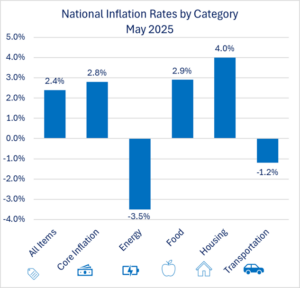In a time of economic uncertainty, there are many factors that influence the direction of an economy. At a policy level, decisions from the Federal Reserve play a big role in determining the course of the nation.
The Federal Reserve functions with two goals: keeping prices stable and moving the country towards maximum employment. The adjustment of interest rates is used as a tool to accomplish this dual mandate. If the Federal Reserve wants to stimulate the economy, it lowers rates, and if it wants to slow inflation by cooling the economy, it increases rates. Movements in inflation and decisions surrounding interest rates can give us a pulse check on how the economy is doing—updates in the last couple of weeks show a steady, but still uncertain, economy.
D.C. Decisions Make a Florida Impact
Changing inflation and subsequent interest rate cut decisions are made at the national level, but they certainly trickle down to impact Florida. Although the Federal Reserve’s interest rate cuts only directly impact the federal funds rate (the interest rates banks charge each other to borrow money), there is an indirect impact on interest rates for the consumer, such as credit card, mortgage, car loan, and business loan interest rates.
These decisions may be made almost 1,000 miles away in Washington, D.C., but Floridians should be tuned into how inflation is motivating the interest rate decisions that influence consumer spending and the pace of future economic growth.
Inflation Sees Only a Slight Uptick
In May 2025, U.S. prices were 2.4% higher than they were a year ago, only a small uptick from the national inflation rate of 2.3% in April. All eyes were on last weeks’ release of updated inflation rates, as consumers were expecting a larger increase in the rate as the result of tariffs. However, this uptick of 0.1 percentage point was smaller than expected, which could mean either tariffs will not have as big an impact as initially anticipated, or the impacts have not yet made their way to consumer prices.
In addition to measuring overall inflation, measuring inflation by category provides a snapshot of how prices are changing across different types of goods. In May, core inflation—which includes all goods except for energy and food, as their prices are more volatile—was 2.8%, which was steady from the month prior. The lower-than-expected increase in overall prices was led by a drop in energy prices over the year. While many categories see prices inflating annually, energy prices are often fluctuating, deflating in 9 out of the past 12 months. Alternatively, housing prices frequently have higher inflation rates, increasing by 4.0% over the last year.

Interest Rates Hold Steady
As inflation and other economic indicators fluctuate, the Federal Reserve adjusts interest rates in response. The Fed holds eight scheduled meetings each year to evaluate data like inflation and labor market performance, ultimately determining whether to raise, lower, or maintain interest rates as part of its monetary policy strategy.
This past Wednesday, June 18, the Federal Reserve announced that there would be no movement in interest rates as they continue to take the “wait and see” approach. This cautious strategy is informed in part by the lingering uncertainty about whether the steadiness in inflation will be disrupted by future impacts of tariffs, or if they will ultimately have little effect. The national labor market has been steady, with the unemployment rate ticking up 0.1 percentage point since December of last year. The Federal Reserve gave its perspective on this trend in its June 18 statement, saying, “The unemployment rate remains low, and labor market conditions remain solid.”
Interest rates can be a powerful tool in the trends for both inflation and the labor market, so as uncertainty continues, the Federal Reserve is cautious. The decision to hold off on cutting interest rates is intended to prevent inflation from rising, which could happen if lower borrowing costs encourage more spending.
While there is no sign of movement on interest rates for now, a majority of Federal Reserve officials project 2 rate cuts
At first glance, unchanged interest rates may not seem newsworthy, but in reality, this signals something important. Steady interest rates indicate that the Federal Reserve is prioritizing price stability, while little movement in inflation and a low unemployment rate reflect an economy expanding at a solid pace—which is an economy capable of handling the wait-and-see approach.
Stay Informed
To stay up to date as new data is released on inflation, interest rates, labor market statistics, and more, visit TheFloridaScorecard.org and subscribe to our Florida Chamber Foundation’s Florida By the Numbers economic updates for an in-depth analysis on how these figures impact the way we live and do business in Florida.